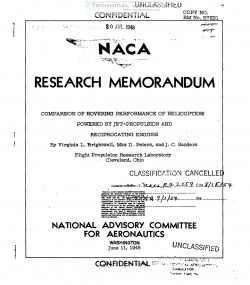naca-rm-e7k21
- Version
- 48 Downloads
- 1.11 MB File Size
- 1 File Count
- April 21, 2017 Create Date
- April 21, 2017 Last Updated
National Advisory Committee for Aeronautics, Research Memorandum - Comparison of Hovering Performance of Helicopters Powered by Jet-Propulsion and Reciprocating Engines

Maximum hovering time, or time that a helicopter can sustain
itself without motion, was calculated for helicopters powered by a
reciprocating engine, by a Nernst turbine rotor, by ram-Jet engines
at the tips of the rotor blades, and by pulse-Jet engines at the
tips on? the rotor blades. The calculations showed. that the conven-
tional reciprocating engine permitted much longer hovering time
than the Jet-propulsion engines investigated, but because the Jet-
propulsion engines were lighter than the reciprocating engine, the
Jet-propelled helicopters could. lift greater disposable loads. 01‘
the Jet engines considered, the pulse—Jet engine allowed the long-
est hovering time, which was about 15 percent of the hovering time
possible with the reciprocating engine.
The helicopter, unique in its ability to sustain itself with-
out motion, is useful for inspection, observation, and photographic
purposes. Although helicopters powered by Jet—propulsion engines
have recently been considered, at the present time a limited emomt
of performance data is available. Previous analytical studies of
application of Jet-propulsion drives to helicopter rotors are
reported in reference 1 and in unpublished data from the University
of Southern California. In reference 1, consideration was given to
ram Jets on the rotor tips and to a rotor with tip Jets supplied
with air fed from a compressor mounted in the airframe. The range
of the helicopter powered by Jets supplied by an engine—driven
compressor was estimated to equal that of a conventionalhelicopter,
but the range of the helicopter powered with ram Jets was consid—
erably less.
Marquerdt and DeVault of the University of Southern California
studied tip-located ram Jets and pulse Jets as well as tip
Jets aspirated by a hub-located, engine-driven compressor or by
a hub-located, rotor-driven compressor. It was found that the
system using tip—located ram Jets would be economically feasible
for cruising endurances less than 1 hour, the tip-located inter-
mittent system and the rotor-driven compressor system for endur-
ances less than 2 hours, and the engine-driven compressor system
for endurances from 2 to 4 hours. For these periods, such systems
appeared to be able to carry approximately twice the pay load of a
conventional helicopter of similar size at cmparable cost.
| File | Action |
|---|---|
| naca-rm-e7k21 Comparison of Hovering Performance of Helicopters Powered by Jet-Propulsion and Reciprocating Engines.pdf | Download |

Comment On This Post